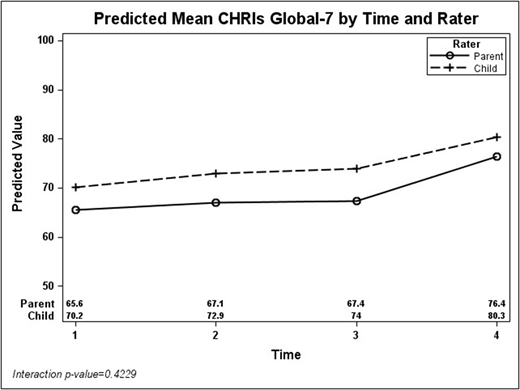Abstract
Introduction: The treatment of advanced stage HL typically includes dose-dense chemotherapy with or without involved field radiation. However, little is known about the HRQL of pediatric patients during initial treatment. We describe the HRQL trajectory over time by child and parent-proxy rater and examine baseline patient characteristics associated with the trajectory.
Methods: Children and adolescents, ages 5-17.9 years newly diagnosed with advanced stage HL and enrolled in Children's Oncology Group AHOD 1331, and their parents were co-enrolled in an embedded study to assess HRQL (n=310). Children (age ≥11 years) and parent proxies (of children 5-17.9 years) reported on the child's global HRQL using the Child Health Rating Inventories (CHRIs) at four times: (1) baseline, (2) cycle 2, (3) cycle 5, and (4) end of therapy, approximately 6-7 months following initial diagnosis. The 7-item CHRIs-Global yields scores that range from 0-100, with higher scores indicating better HRQL. A repeated measures linear regression model was fit with categorical time (reference, baseline), rater, child race, ethnicity, and continuous age. An interaction of rater and time was tested and predicted means were plotted.
Results: 97% of age-eligible patients and parents completed baseline HRQL assessments with 93% completing planned follow-ups. Median child age was 15.5 years (q1=5.4, q3=18.9) and 50.3% were female. Most children were white (76.1%) and non-Hispanic (82.6%). There was no significant interaction between rater and time (Figure), so this was subsequently excluded from the model. Scores improved slightly at time 2 (β=2.5, 95%CI=0.3, 4.6) and 3 (β=2.8, 95%CI=0.3, 5.3) compared to baseline; larger improvements were seen by time 4 (β=10.6, 95%CI=7.9, 13.3) after completion of therapy. Children reported higher HRQL than their parent proxies (β=5.6, 95%CI=3.9, 7.2), males had higher HRQL than females (β=4.6, 95%CI=1.0, 8.3), and older age was associated with lower HRQL (β=-0.8, 95%CI=-1.5, -0.1). There was no significant effect of race or ethnicity.
Conclusions: Completion rates of HRQL were high across all time periods and for both raters. HRQL, impaired at baseline, likely from the disease process, improved slightly during treatment, with larger improvements by the end of initial therapy. Future research will examine how clinical and treatment factors impact the HRQL trajectory.
Parsons:Seattle Genetics: Research Funding. Rodday:Seattle Genetics: Research Funding. Henderson:Seattle Genetics: Research Funding.
Author notes
Asterisk with author names denotes non-ASH members.


This feature is available to Subscribers Only
Sign In or Create an Account Close Modal